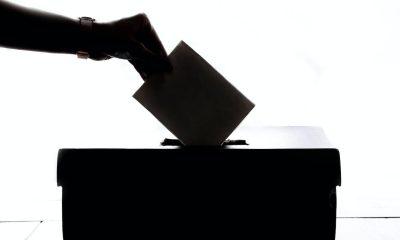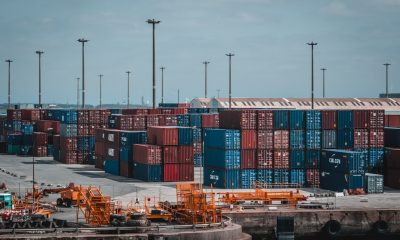Canada News
In Doug Ford’s e-learning gamble, high school students will lose

The Ford government’s plan will increase the number of e-learners by 95 per cent. That will drive students towards a model of education that is still developing and has been criticized for its negative impact on student outcomes south of the border. (File Photo: FordNation/Facebook)
Next school year, Ontario plans to launch a massive learning experiment with high school students that seems set to increase inequality and compound failure for students already struggling in face-to-face classes.
The Ministry of Education, under Doug Ford’s Progressive Conservative Party, plans to require students to take a minimum of four e-learning credits to graduate. This announcement came this past March. The province also plans to “centralize the delivery of all e-learning courses.” This means school boards will have less control over how e-learning is administered locally.
There’s been little detail about how the province will oversee or run e-learning, beyond a 2020-21 phase-in. If Ontario indeed introduces e-learning with no in-person class hours — what’s called “supplemental e-learning” — each student will lose 440 hours of face-to-face class time.
Questioned in the legislature about the plan, Lisa Thompson, then the minister of education, asked:
“What is wrong with making sure that our students, at minimum, once a year, embrace technology for good?”
The fantasy of progress reflected in this statement — that technology can determine educational outcomes — suggests that technology offers simple solutions to complex problems.
I am part of a chorus of voices critical of Ontario’s proposal. My perspective is informed by my doctoral research in the department of geography at the University of Toronto on e-learning in the Toronto District School Board (TDSB), and my extensive background teaching e-learning as a secondary school teacher in the same board.
Bad policy
Forcing high school students to take e-learning courses when they get more support in face-to-face classes is bad policy. Advancing mandatory e-learning risks diverting resources and energy away from young people who have a right to a robust and culturally responsive education right where they live. In this way, advocating mandatory e-learning for high school students risks contributing to inequitable public policy.
Research by education researcher Carl James at York University has shown that inequitable public policy impacts Black students disproportionately; scholars Anita Olsen Harper and Shirley Thompson at the University of Manitoba highlight that the lower graduation rate for Indigenous students is due to the many structural oppressions that Indigenous people experience including schooling that doesn’t address the realities of racism or provide support for students to enhance their traditional practices.
Since the announcement, schools and students have criticized Ontario’s plan: an Ontario Student Trustees’ Association survey found that almost 95 per cent of 6,087 student respondents said they “disapprove of the new e-learning mandate.”
Educational experts have spoken out against the scale, speed and lack of detail.
The previous provincial government also rejected mandatory e-learning because it was “not appropriate to address the learning needs of every student.”
Corporations in classrooms?
According to a People for Education 2019 survey of Ontario schools, currently “an average of five per cent of students per high school participate” in earning credits through e-learning.
The Ford government’s plan will increase the number of e-learners by 95 per cent. That will drive students towards a model of education that is still developing and has been criticized for its negative impact on student outcomes south of the border.
In the United States, five states mandate one credit in e-learning to graduate. If the U.S. offers a lesson, it’s that e-learning will expand the influence of corporations and private interests.
In Canada, British Columbia leads in e-learning activity, but the majority of students are concentrated in independent (private) schools.
E-learning in Toronto
In 2016, I conducted a year-long study to examine how students understood the role of e-learning as part of their schooling experience in the TDSB, the largest and one of the most diverse school boards in Canada.
I interviewed 20 students multiple times each semester in seven e-learning classrooms across all disciplines, such as health education, math and science and core English courses. I also interviewed 30 stakeholders, including parents, administrators, e-learning teachers and guidance counsellors.
I also observed more than 3,000 discussion threads and 60 hours of virtual classes.
Virtual classes are video conferences where students can meet the teacher and peers in real time to ask questions and review content. The teacher records the class and posts it on the homepage so students can access the sessions. Virtual classes are poorly attended in real time, and students I interviewed inconsistently watched the recording after it was posted. Since flexibility is one benefit of e-learning, teachers can’t force students to attend a live virtual class.
High achievers and inequality
The reality of supplementary e-learning in Toronto right now is that course offerings target already high-achieving, university-bound students.
I found that 52 per cent of students taking e-learning were concentrated in 12.5 per cent of schools that the board classifies as having higher learning opportunities. Students were more likely to be concentrated in the most privileged schools in the city.
These schools are in communities that are richer and whiter than those facing greater external challenges. This was true not only of the year I conducted my study but reflects data I collected on student enrolment spanning almost a decade.
The typical e-learning student in my study was already successful in a face-to-face class. They often enrolled in e-learning because it was an efficient way to earn a credit. They spent significantly less time online than they would face-to-face, which expanded their schedule to participate in extra-curricular activities needed for university admissions or to prioritize other classes.
Students also took e-learning to boost their “top six” average for applications to competitive programs. More uncommon were students who needed e-learning because they were unable to regularly attend school face-to-face. For students struggling with mental health or on a competitive performance schedule in athletics or the arts, e-learning was necessary and valuable.
Overall, e-learners were an exclusive group of students who possessed the soft skills and institutional knowledge to succeed; this is typical of programs of choice.
One should not deduce that based on this group of students’ success, all students will succeed with e-learning.
And, overall high student achievement in e-learning cannot be conflated with the meaning of student e-learning or school experience: For example, I interviewed three Black students enrolled in e-learning who described how racism in school negatively impacted their lives and feelings toward education.
Administrators, teachers and guidance counsellors I interviewed said students struggling face-to-face often struggle further online, especially if they are easily distracted and need support with organization, time management and independent learning. This is why the TDSB encourages students to take a “readiness survey” to determine if they are a good fit for e-learning.
Blended model is better
Although I’m critical of mandatory supplementary e-learning directed by the province, I’m optimistic about how e-learning can be integrated into face-to-face classes in what’s called a “blended model” of instruction.
Blended instruction provides teachers a way to meet a greater range of learning needs without abandoning the benefits of face-face supports.
If the province is serious about their commitment to students, they would invest in rather than divest from public education, and learn from the many teachers already integrating e-learning in traditional classrooms.
———
This article is republished from The Conversation under a Creative Commons license. Disclosure information is available on the original site. Read the original article:
https://theconversation.com/in-doug-fords-e-learning-gamble-high-sch





















